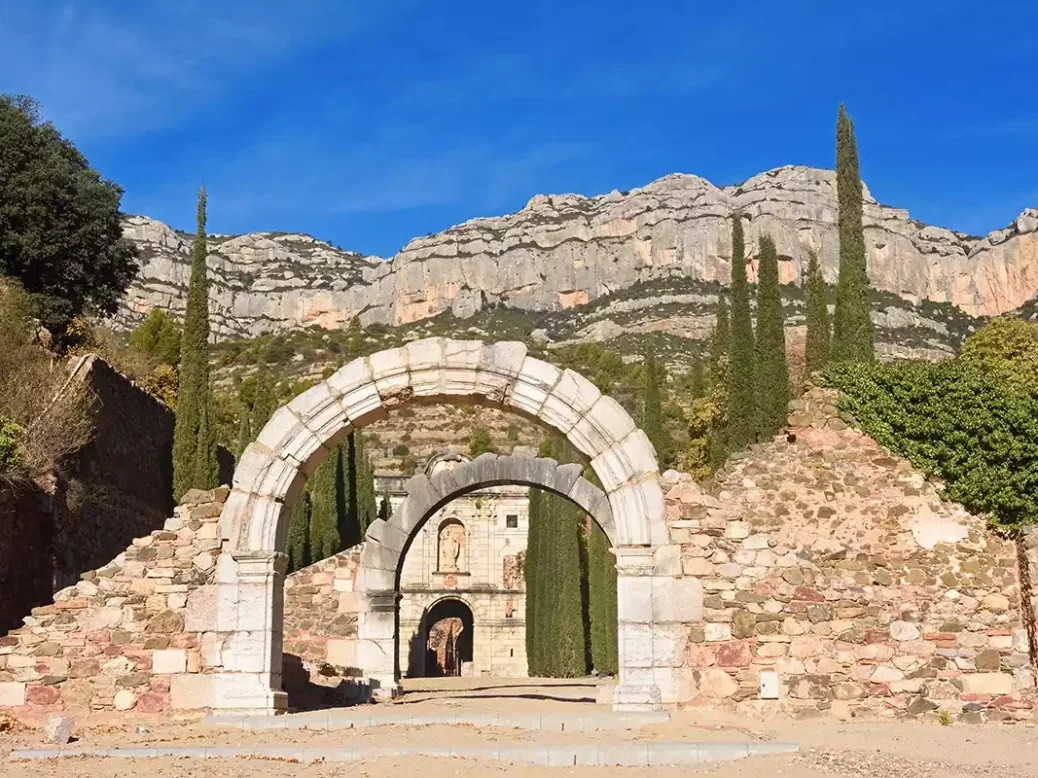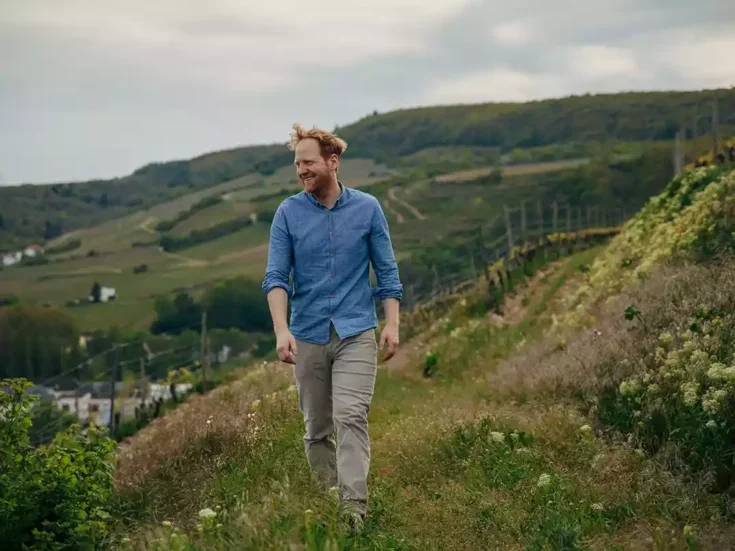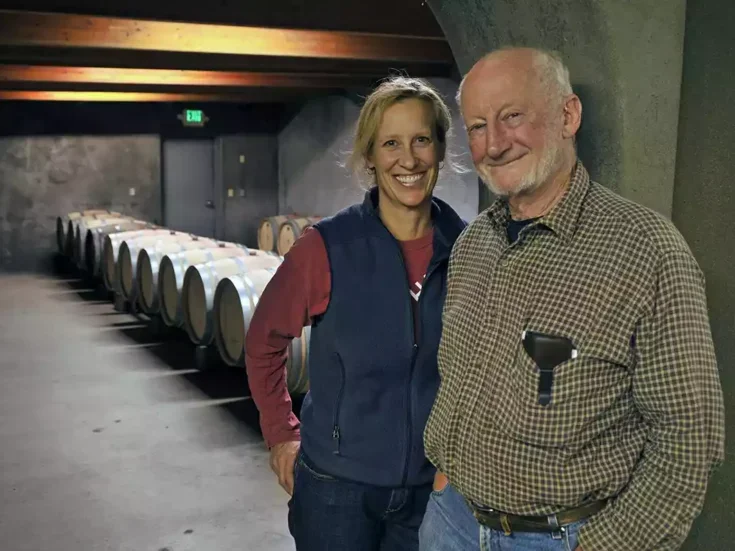
Andrew Jefford tastes 2019 Torres Mas de la Rosa Vinyes Velles Porrera Priorat.
The wind was blowing, I remember. Not a gale, but the air was in movement. We wanted to taste this wine in the vineyard from which it had come—so here we were, glasses in hand: Jamie Goode and I, with Fermí Ferré, who looks after the vines, and Isabel Vea Barbany, who speaks beautiful English, as well as Spanish and Catalan and could help us all find words to share.
Priorat suggests this. I’d done the same with Bixente Oçafrain of Mas Alta in La Vilella Alta, when I’d been here in 2017, drinking white Solana Alta 2014 in vineyard light that was glittering even on All Hallows’ Eve. Mas de la Rosa 2019 (in April 2024) was pale red, a blend of 60% Carinyena and 40% Garnacha, with a few rogue vines of Picapoll.
There is, though, a drawback to tasting wines in vineyards. We sniffed—but it was the wind that stole off with the wine’s aromas, to enjoy behind a rock, or soaring over the valley, or surveying the Scala Dei, God’s Ladder, a series of cliffs lying 10 miles (16km) farther north. Never mind: This seamless, calm red had hidden aromas inside its flavors, too. The wild lavender was in flower in the unpeeled spring air all around us, so it was hard not to imagine its pungent clutch in the wine; we also thought of roots and warmed stone and salt. Elemental notes, not necessarily lovely, wrapping themselves around the shapely fruit and lending density to the tannins. Grand wine, but unshowy. Hard not to see it as a part of the place, like the almond trees, the watching pines, or the nightingale whose song filled the valley below.
Miguel Torres Maczassek remembered this small vineyard from the moment he first drove over the track that leads there. Indeed, he couldn’t forget it; it haunted him. It was eventually purchased in 2016—13ha (32 acres) of land, but only 1.9ha (4.7 acres) of old vines, those vines planted as France collapsed under the Nazi advance; it’s their fruit that gives us this bottle. An earlier idea was to include it in Salmos, which since 2017 has been a Porrera Vi de Vila (village wine), or the old-vine cuvée, Perpetual; but it begged for separation. “Miguel always insisted,” winemaker Jordi Foraster told us, “that the landscape is what matters. This is our main goal: to show you the place, the vineyard.” It could, I thought, have been different, with different souls in charge. There are only 1,500 bottles for the world. Why not make something showy, a thumper? This wine could have been a rock anthem. Instead, Miguel and Jordi crafted plainchant.
The long, seven-century Reconquista saw the Moorish overlords leave this part of Al-Andalus in the 12th century; Tarragona was recaptured by Ramon Berenguer III by 1118, becoming the ecclesiastical seat of Catalunya Nova. Alfonso II of Aragon, the troubadour-king who ruled both Barcelona and Provence, established Cartoixa d’Escaladei or the Scala Dei Charterhouse—the first Carthusian monastery on the Iberian peninsula—in 1194, its express aim being to repopulate and Christianize the abandoned interior. Alfonso’s grandson Jaume I of Aragon, born in Montpellier, gave the monks the villages of La Morera de Monsant, Gratallops, Torroja del Priorat, Porrera, Poboleda, and La Vilella Alta in 1218; and with the monks came vines. “Priorat” came into being to the sound of monastic chant. It’s the only wine region in the world that began as a gigantic priory garden.
Standing vines in a turning world
Will Priorat last? Will it survive climate change? “The business,” says Jordi, “is terrible.” He’s tall and thin; robed in white, he’d make a convincing Carthusian. Five thousand vines, he means, yield just 1,000 liters (264 US gallons); three recent drought seasons toll ominously. Those vines stagger, bend, and hunch in the dark Porrera schists; even normality is penance. Mas de la Rosa costs more than €300, though Torres’s other Priorat wines are cheaper. “But if you can’t sell these wines at such prices, the vineyards will die. Nothing is easy here in Priorat. Anyone who buys Mas de la Rosa is making an act of generosity,” Jordi says.
Stat crux dum volvitur orbis, as the Carthusian motto has it: “The cross stands while the world turns.” Terrible things are happening in the world as it turns, as they always have; I thought of some of those, too, as we tasted in the peaceful vineyard light that April morning. The stealthiest yet the most implacable of these terrors is humanity’s wild climate experiment, and no large-scale wine producer is more active in responding to that than Torres. The next day we met Miguel Torres Sr, still sprightly and involved at the age of 82. I mentioned our failure to achieve the 2015 COP21 Paris Agreement goals; quisling legislators and executives are busy reneging on their commitments. Where do we go from here? “All we can do is adapt,” he said, with a grim half-smile. Torres is attempting to do this, on many fronts.
As we drove away from Mas de la Rosa, we saw a vineyard on a plunging hill across the valley. At its center, a tiny figure, working the vines in readiness for the season ahead, swallowed up by the vastness of the landscape all around. We make beauty with our work and our wines; our vines stand as the world turns. Insouciance may see them fall. ▉






